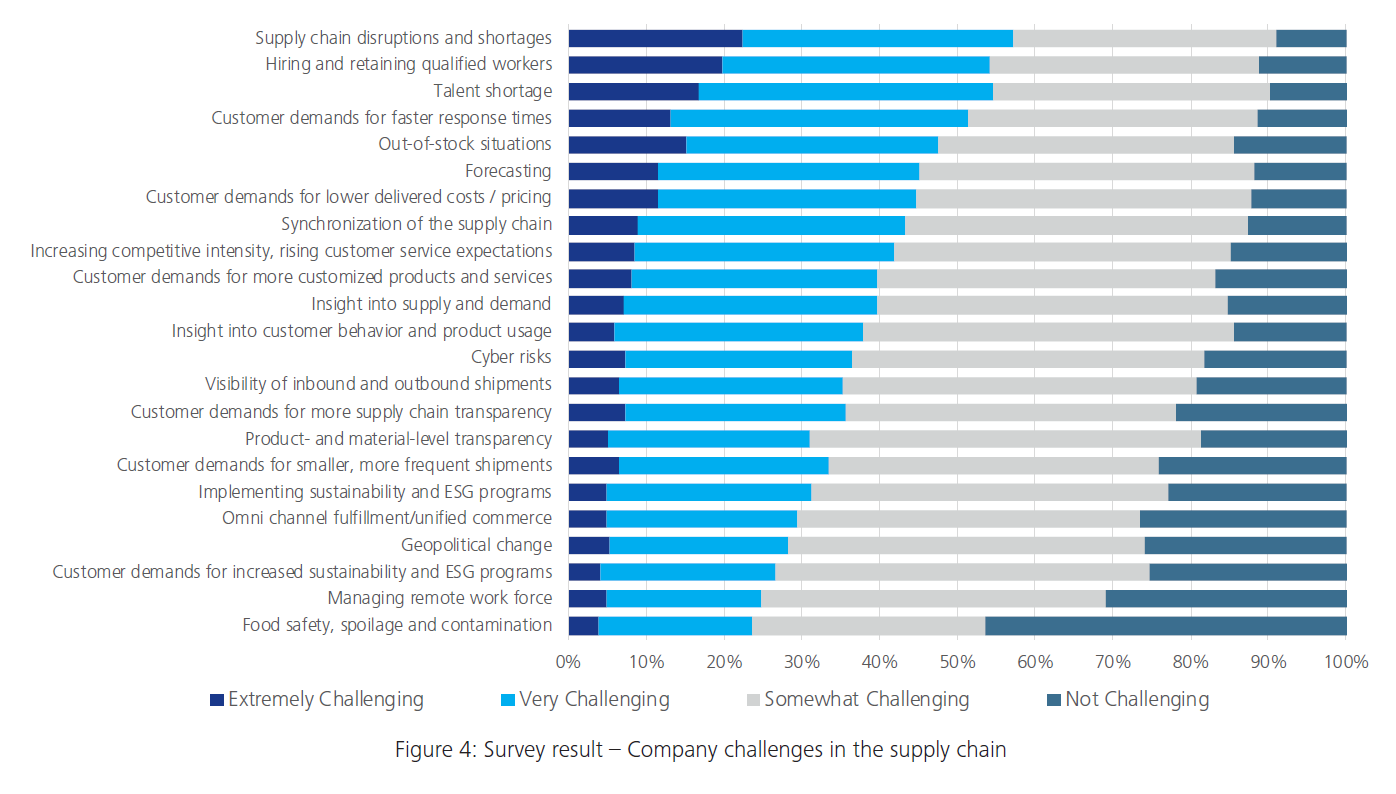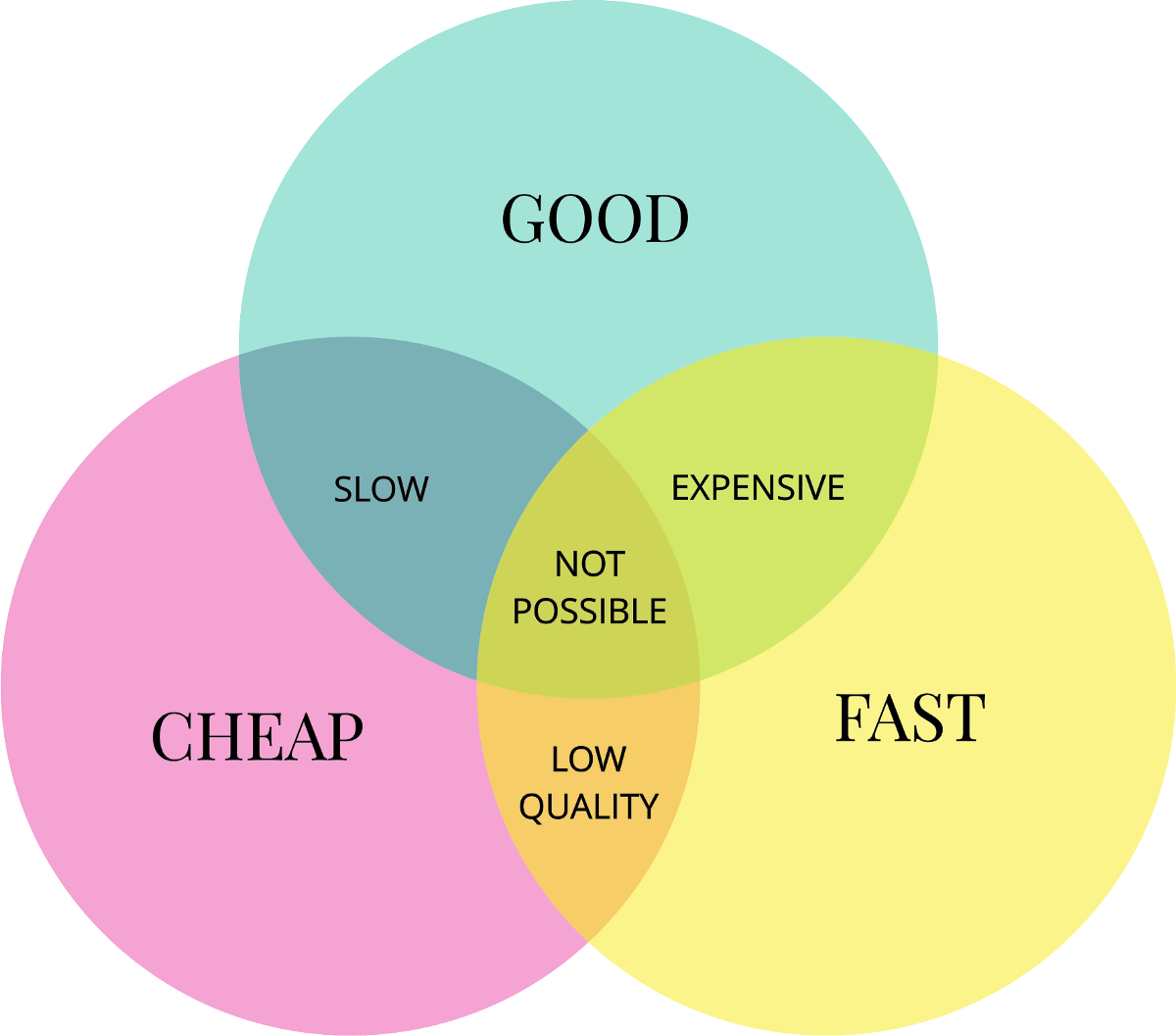
The 2022 Material Handling Industry report, which involved 1,074 supply chain professionals from a wide range of company types and industries, comprehensively surveyed and discussed various challenges facing their businesses. The respondents had to assign a level of difficulty to each challenge and the below chart demonstrates this in detail – from the most challenging to least challenging respectively.

We’ve analysed the findings and believe six themes occur repeatedly. As a supply chain professional, you can address these more significant concepts and start proactively making changes to your business to gain productivity, resilience and competitive advantage for business growth.
Let’s dive into these themes and see how implementing technology platforms like SourceDogg can help you address the challenges in your business.
Disruption
Main Challenges:
- Supply chain disruptions and shortages
- Out-of-stock situations
It’s been impossible to ignore the severity of the supply chain disruptions over the past couple of years, but the survey gives the reassurance that you’re not alone in this particular challenge.
We’ve already written various articles on avoiding a crisis in the supply chain using technology, how to deal with the impact of inflation, and offered strategies to boost supply chain performance in complicated times.
The main takeaway is that the most resilient businesses have a great handle on their data and supply chain relationships that enables transparency and an insightful understanding of their supply base. This knowledge empowers digitally-led businesses to make evidence-based decisions that are wiser and not based on anecdote or emotion.
We’ve also got a great on-demand webinar on how data can become insight and this insight is essential to dealing with disruption – whatever your industry.
People
Main Challenges:
- Hiring and retaining qualified workers
- Talent shortage
- Managing the remote workforce
It’s clear that finding, hiring and retaining supply chain superstars is a difficult task for many businesses and the new hybrid working models have also made some adjustments to how employees want to work. Attracting the right talent has changed too – post-pandemic it feels like every role has to be a hybrid role and adapting to that change alone has forced many businesses to shortcut or speed up their digital transformation.
This change has also created more issues downstream, such as the need for centralised cloud data on the supply chain – accessible from anywhere by any team in a de-centralised and multi-location workforce. That’s why SourceDogg exists!
We’re here to help you get the info out of the inbox, away from impenetrable shared drives and turn it into insight.
Changing Customer Expectations
Main Challenges:
- Customer demands for faster response times
- Customer demands for lower delivered costs/pricing
- Customer demands for more customized products and services
- Increasing competitive intensity, rising customer service expectations
Customers eh… who’d have them!?
In all seriousness though, the changing customer landscape poses plenty of issues for the supply chain teams across most industries. We understand that not every business is consumer-facing and under the same kind of expectations as eCommerce giants like Amazon, where even a missed nominated delivery time feels like a monumental failure but the sentiment is still present amongst today’s customers regardless.
Customers seem to expect more, more quickly, to their exact specifications and for as little money as possible. This psychology has ratcheted up in recent years with a seemingly never-ending level of abundance in supply and choice for consumers that has bled into the professional buyer’s mindset.
The solution to this challenge isn’t straightforward, it’s a multi-faceted combination of supply chain and sales portfolio management, balanced with commercial and strategic marketing foundations. However, trying to balance risk and commercial benefit without a clear and data-driven approach to these various disciplines makes success much harder.
It reminds us of this Venn diagram:

Faster – This is a balance of risk in stock holding and cash flow vs. supply chain planning and mapping to understand lead times. Do customers really NEED it the next day or do they just WANT it? Are they willing to pay for this privilege? What are the cost implications of this? This is a multivariate analysis situation and without data to power it… it’s nigh on impossible to do accurately.
Cheaper – Many people know the cost of everything and the value of nothing… but this is where competitive pricing analysis comes into play and marketing strategies to try to assess the elasticity of the market. Do you really need to be cheaper or simply make the customer believe they’ve got a bargain best price?
Customised – balancing the commercial opportunity of endless customisation with “off the shelf” options to cover most bases. We doubt most consumers take the Nike iD customised footwear approach, moreover they opt for the slightly lower cost, insight-driven options. Without data to analyse demand, consumer insight, supply chain challenges and costs, the customer will always ask for the moon on a stick… until it’s at a price they cannot afford.
Embedding data into the decision-making process on what you offer the customer and the upstream impact on your supply base is essential.
Processes
Main Challenges:
- Forecasting
- Synchronization of the supply chain
Forecasting and synchronisation both rely on scenario modelling across the supply chain. Data and technology are simply essential to this process. If you’re targeting sales growth and it’s a realistic pipeline and not a moonshot – then synchronising the supply chain to deliver this added demand is essential to achieving commercial success. But does your supply base have capacity? Can they adapt? Do you need alternative sources for services or components? Without a supply chain technology platform like SourceDogg to manage your data and supplier relationships, these processes are made much more difficult.
Insight
Main Challenges:
- Insight into supply and demand
- Insight into customer behaviour and product usage
Supply and demand insight is incredibly useful and core competence in today’s forward-thinking supply chain manager’s repertoire – but the more data they can have at their fingertips the better the decisions they can make. Without accurate, consistent, complete and relevant data the best decisions can’t be made. Sometimes this is augmented with data from different departments or third-party sources too – so connecting data for business intelligence-level analysis is becoming essential for competitive advantage.
Behaviour and product usage may seem like a consumer-focused challenge and be seen as a marketing or sales role, but customer behaviour drives tomorrow’s market requirements. Working closely with insight teams and product designers enables the supply chain team to be a step ahead in strategically aligning suppliers to longer-term challenges rather than dealing with issues as they arise.

Sustainability
Main Challenges:
- Customer demands for more supply chain transparency
- Implementing sustainability and ESG programs
- Customer demands for increased sustainability and ESG programs
Authentically delivering on sustainability promises for investors and customers alike is one of the main supply chain strategies we’ve identified amongst market leaders in the coming years.
If companies want to achieve competitive advantage and tick all the right boxes to win work contracts in the future, visibility and transparency on all of the associated ESG and DEI metrics need to be identified, collected, and analysed and then planned against for improvement.
We’ve seen lots of our clients come on board for exactly this reason – to collect and store data centrally across a huge array of functions so that it can be analysed and presented in audits quickly and effectively.
We’re up to the challenge…
It’s clear that the supply chain industry is full of challenges and we’re certainly not pretending that data and technology will provide a singular solution or crystal ball to foresee the future.
However, we do know that many of our clients that we work with every day find the structure, control and shared cloud infrastructure of SourceDogg immeasurably helpful in helping them achieve their goals.
Supplier Master Data empowers our customers’ teams to make more evidence-based confident and strategic decisions that spark creative solutions to their problems.
They can then use our Source + Select features to manage buying and sourcing events and Supplier Relationship Management brings together the data and insight to drive mutually beneficial objectives for working together proactively in the future.
We’d love to show you the platform in the context of your business challenge, so get in touch for a personalised demo today.





